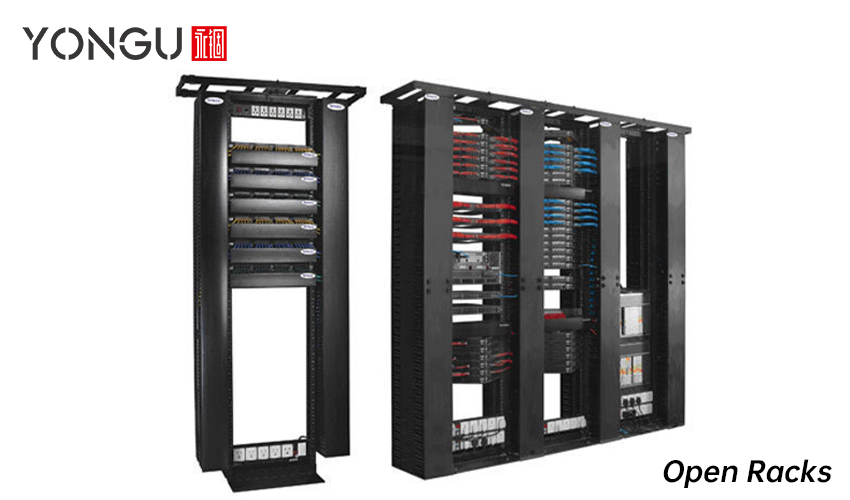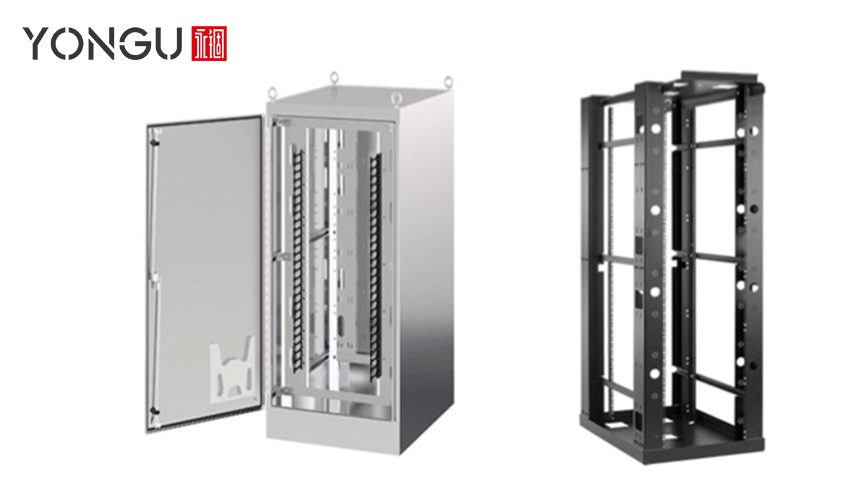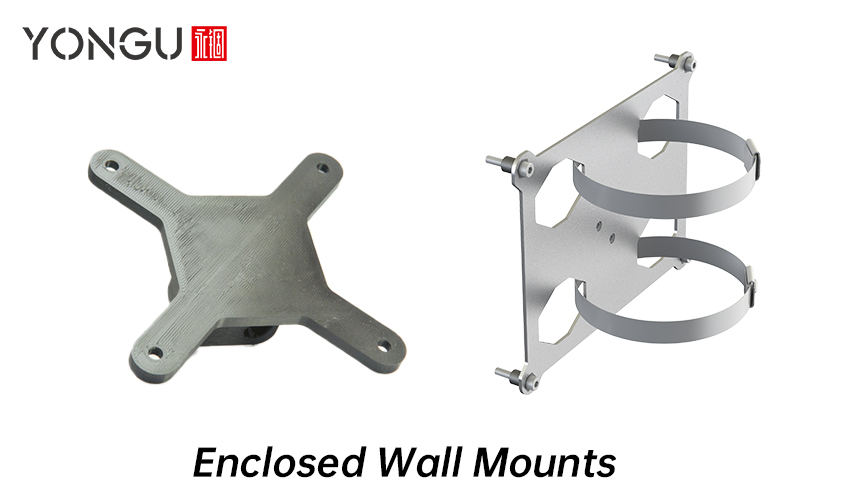
TYPES OF ENCLOSURES AND CABINETS
Floor Mount Cabinet Racks
These are the most significant electronic enclosures and come in numerous forms with several attachments. They are available in 19, 23, and 24-inch broad panel spaces but customization options are available based on the customer and application requirements. When it comes to storing rack-mountable equipment, an enclosed cabinet is a great option. Equipment cooling may be more easily managed in an enclosed rack. To control airflow, ventilated panels and fan trays and arrays are available. To keep equipment safe, many enclosed cabinet designs allow for the addition of lockable supplementary front and rear doors or translucent doors that will enable equipment monitoring. Before deciding on a particular model, applicable rules and regulations must be considered.
Server & Co-Location Racks
In most cases, applications that ask for a high ventilation level and adequate air circulation will demand for their utilization. The only difference between cabinet racks and server racks is that the server racks have completely ventilated doors and side panels. For added protection and psychological comfort, consider installing a front door that is either made of sturdy metal, glass, and has a lock. Additional cabinet depth allows for the installation of larger instruments. Like server racks, co-location crates are partitioned into discrete compartments and may be used to house many servers. Sections range in elevation from 24 to 39 inches and are meant to be completely self-contained and safe. Cabinet rack assemblies can have side panels that are single-piece components that extend to the entire height of the cabinet.
Seismic Racks

Equipment that is vulnerable to shock and vibration can receive the most protection possible against seismic activity with the use of seismic racks. Telcordia #63-GR-CORE standards evaluate seismic cabinets with the most rigorous regulations. A cabinet's rated weight-bearing capability is typically based on an evenly distributed load. If your cabinet is going to be used in an environment that involves either mobility or shock, you might need to conduct an evaluation using real or simulated load conditions. Seismic cabinets should be securely fastened to the floor using appropriate anchoring equipment.
Open Racks
If you need maximum cooling or direct access to your apparatus's front, back, and sides, an open-frame rack is the best option. There are 23" and 19" wide open frame racks for instrument panels. Open frame racks should be utilized in locked rooms if security is also a key factor. With limited floor space in mind, wall-mounted is considered as the alternative for open rack enclosures. Wall-mounted designs come in fixed and swing frame varieties, to provide access to the back panel. The rails that make up the rack structure hold all the load's weight. A large enough base and a sufficient weight capacity are necessary to ensure that the rack is stable when congested.
Enclosed Wall Mounts
Using wall-mounted enclosures might be a premium solution for situations in which the required amount of equipment is expected to stay minimal and consistent. Other options include cabinets with two hinges that flip like a book to reveal back panels or various levels of rack mounting space. Some variants come with doors that may be locked or made visible for easy access to the equipment panels.

Rack Mount Chassis
Rack-mounted equipment and instruments can be assembled in various enclosures provided by rack mount chassis. It is possible that some rack-mounted equipment, which may also be used on a desktop or as portable equipment, will require detachable handles or other types of gear. Maintaining proper operating temperatures necessitates the provision of ventilation panels.
Card Racks
Customizable electronic instrumentation may be assembled using card racks and chassis-like containers for assembling circuit boards and accessories. The card rack is made to fit into a 19-inch rack. Modifications to the equipment may be made quickly and easily by rearranging the modules. Rails, guides, connections, locks, and other hardware within the modular chassis are required for each unique submodule in a lattice structure. Adherence and misalignment may be avoided by ensuring dimensional correctness and steadiness.
Portable Cabinets
Portable cabinets are 19-inch-wide instrument racks that can hold a small quantity of gear. It's difficult to fit power strips and other supplies inside mobile cabinets. It's common for there to be no internal structure. There are no casters, levelers, or anchor kits outside portable cabinets. The load capacity is 500 lbs. Robust surfaces should be used to support heavy cabinets.
Small Metal Cabinets
Instruments and equipment with a maximum volume of one cubic foot are packaged in small cabinets. A few examples of useful features found on small cabinets are strap handles, tilting doors, slanted stumps, and locks. Although rack mounting gear may be provided for certain kinds, they are not designed to be mounted to a rack.
Chassis
Electronic circuits benefit from having support and protection provided by metal chassis. There is frequently an option for a bottom cover. Be sure to check the measurements and accessories for the particular chassis variants.
ACCESSORIES WITH CABINETS & ENCLOSURES
Cooling
To keep the temperature within the enclosure, rack, or cabinet consistent, you will need vents, trays, air blowers, and thermostats.
Power Management
Metal Cable brackets, electrical line conditioners, and distribution units are essential components for improving the aesthetics of the interior of cabinets and enclosures, preventing surges, and clearing up any needless complexity.
Internal Plunge Hardware
Screwed or threaded flanges, brackets, sliding brackets, and dongles are all included in this category.
External Panels & Hardware
This includes screw heads, nuts, washers, clip nuts, blank filler panels, handles and locks, and screws.
Shelves & Drawers
This encompasses fixed and sliding shelves, drawers along with folding and non-folding desktops.
Transport & Anchoring Hardware
This comprises casters, feet, and levelers, as well as seismic anchors, anti tippers, and other forms of safety equipment.
SUPPLEMENTAL INFORMATION
Whether designing an electrical box for the telecommunications industry or constructing vertical bike storage, the enclosure should ideally be strong, long-lasting, and safe. Although the standards for industrial cabinets vary across sectors, the requirements remain the same.
The following is a list of the specific parts that can assist you in the construction of robust enclosures and cabinets that are safe and secure.
Bridge Handles
Bridge handles are popular because of their versatility. There are handles made of glass reinforced plastic most suited for 19-inch housing. Still, you may also use steel or aluminum depending on the load capacity if you install the enclosure with a more robust industrial door.
The range of colors available seems to be another consideration. These hues include traffic red and orange and different shades like grey, black, and white. There are two possible outcomes: either a handle that stands out against the enclosure's contents as a safety precaution or a handle that blends in with the door or component it is attached to.
Quarter Turn Latch Kits
It is common practice to restrict access to electrical components such as fuse boxes to just a handful of individuals, primarily Technicians and Engineers, in public safety. Locks catches and latches made of stainless steel, polyamide, aluminum, and zinc die cast can be used to secure these enclosures. You may locate square, triangular, keyed, and non-keyed latch kits, among other styles, in a complete line of locking kits before actually making a purchase.
Locking Plates & Security Covers
You'll often need locking plates or security covers to secure your enclosure with a padlock. You should think about the material while storing your cabinet externally because weather conditions will likely influence its durability.
Hinges are often needed in conjunction with locks and catches. Depending on the load capacity and the environment in which it is utilized, various options are available.
Magnetic Catches
Magnetic catches are a great technique to keep enclosures and cabinet doors closed. They're an excellent alternative for storage containers in public settings since they help prevent burglary and secure property. They're simple to set up, durable, and convenient to use.
Hand Knobs
Control panels with pull and control knobs are frequently used in industrial cabinets that contain electrical enclosures, fuse boxes, or other types of equipment. Sometimes it is needed to add an emergency stop button based on your requirements.
YONGU ENCLOSURE SERIES
YONGU offers unique aluminum cases and enclosure options, with multiple advantages and a wide range of products divided into different series.
IP68 Waterproof Aluminum Box
This includes two models, including L Series, 24 different enclosures, and M Series, including 11 different enclosures which are entirely customizable based on customer requirements.
These include enclosures suitable for harsh environments such as heavy machinery, industrial plants, and underwater or outdoor applications.
Rack Mount Enclosures
This includes a single C series enclosure completely customizable based on customer requirements.
Electric Box
This includes three models: the H Series with one enclosure, the J Series with one enclosure, and the K Series with three different models of enclosure completely customizable based on customer requirements.
These include a one-piece structure box, one split type structure, and a protected plastic end cover enclosure.
Sheet Metal Box&ggt;
This includes two models, including E Series, three different enclosures, and S Series, eight different enclosures completely customizable based on customer requirements.
They are entirely customizable with OEM and ODM support services.
Instrument Enclosure
This includes five different models, including A series, B Series, D Series, F Series, and G Series, each with one enclosure completely customizable based on customer requirements.
Amplifier Aluminum Enclosure
This includes a single W series enclosure completely customizable based on customer requirements.
For further information and customized product of your requirements, please follow our FACEBOOK for more updates and informations.
You can also contact us at +86 13326782625 or write us [email protected].



